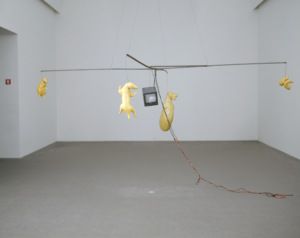Things to do
Early-September Art: On the trail of Copenhagen Contemporary
This article is more than 9 years old.

A performative arena is expected at Nauman’s exhibition (photo: James Isberner © MCA Chicago)
Bruce Nauman
ongoing, ends Dec 22, Mon-Sat 11:00-21:00, Sun 11:00-20:00; Copenhagen Contemporary, Trangravsvej 10-12, Cph K; 50kr; cphco.org
Established as an independent institution, Copenhagen Contemporary (CC) is transforming the former paper halls on Papiroen, located in the Copenhagen Inner Harbour, into a set for changing exhibitions.
The space of CC is an international centre created to host technically demanding formats of contemporary art, such as monumental installations and sculptural landscapes.
Following expositions in major museums such as Guggenheim Museum in New York, the Museum of Contemporary Art in Chicago, Centre Pompidou in Paris and Tate Modern in London, CC is the first art institution in Scandinavia to display a comprehensive exhibition of works by Bruce Nauman, one of the most influential living US artists.
Emerging in the 1960s, Nauman’s earliest work was conditioned by minimalism, conceptualism, performance art and video art. This phase continued to influence the development of his study of the relationship between the view and the sculptural object.
Nauman’s exhibition at CC is presented as a performative arena where the visitor is involved in the space and stimulated in various ways. The use of claustrophobic installations, wordplay in neon and performances bombard the senses, challenging us both physically and mentally. Amongst the artworks displayed are a hanging carousel with animal carcasses, and a work from the Raw Materials series.
Evren Tekinoktay: Bermuda
ongoing, ends Oct 1; David Risley Gallery, Bispevej 29, Cph NV; davidrisleygallery.com
Tekinoktay presents a display of unexplained disappearances through two series of wall-based, neon-relief works, using motorised moving elements, painted plexiglass, mirrored masks and sculptures.
Martin Bigum
Sep 3-Jan 15; Arken Museum of Modern Art, Skovvej 100, 2635 Ishøj; 110kr; arken.dk
Bigum displays his creative process and the importance of inspiration: from works made during the fall of the Berlin Wall in 1989 up until his latest series of paintings, Havet.










































